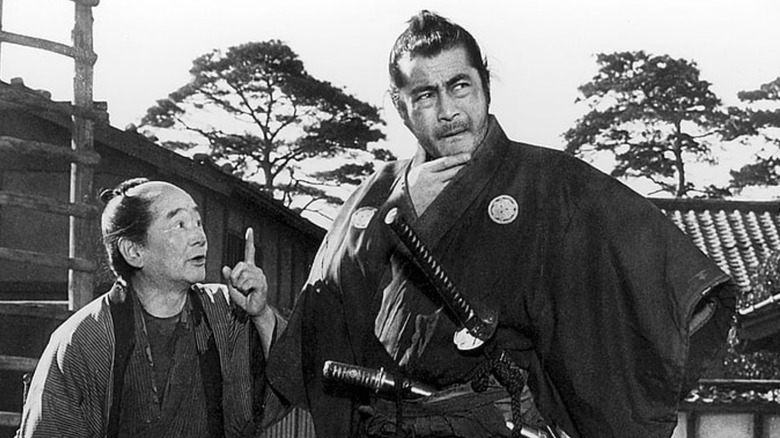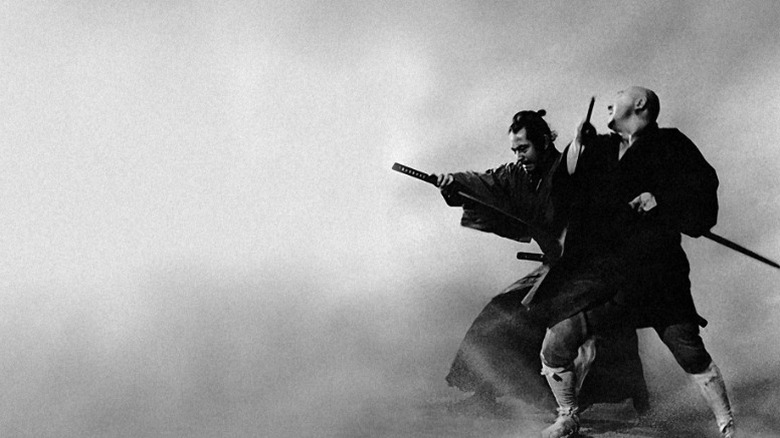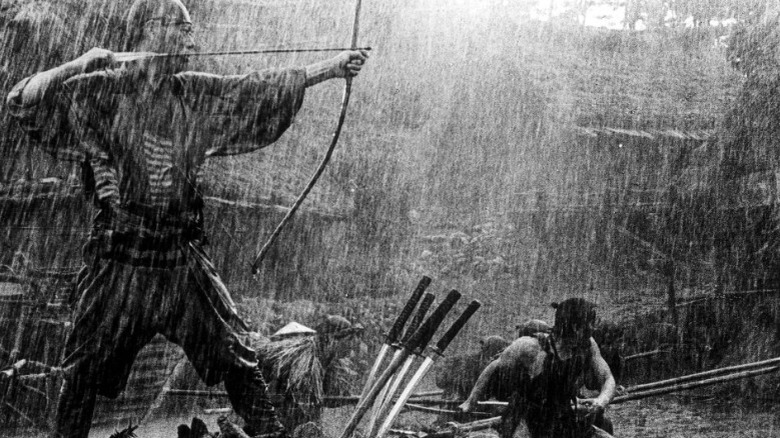Akira Kurosawa's Seven Samurai Should Have Been 'Impossible' To Make In Japan
The global appeal of Akira Kurosawa's "Seven Samurai," which is a fusion of the chambara (swordplay) and jidaigeki (period drama) genres, cannot be overstated. Set during the Sengoku period, "Seven Samurai" hones in on a village pillaged by marauding bandits, which prompts the inhabitants to seek protection from a group of rōnin. Apart from amalgamating narrative tropes to form an almost sublime, engrossing drama about the cycles of shame and violence, Kurosawa uses emotionally-resonant internal conflicts to heighten dramatic stakes, elevating the film beyond the scope of a garden-variety period piece. No wonder "Seven Samurai" still has an overwhelming impact on contemporary action subgenres. Scores of filmmakers owe a lot to the film for cementing the popularity of genre tropes, including heroes assembling to serve a mission and a heroic wild card acting as the catalyst for dramatic revelations to further the plot.
The shadow of influence cast by Kurosawa's most acclaimed samurai film becomes doubly impressive when one considers the practical obstacles that the director faced to bring his vision to life. For starters, "Seven Samurai" was extremely expensive to make, as Kurosawa was obsessively dedicated to creating larger-than-life sets and props that would lend authenticity to the historical era depicted in the tale. Kurosawa's decision to work with a meticulously built set on the remote Izu Peninsula — as opposed to a cheaper, Toho-backed — studio drastically increased production costs, which snowballed into attempts by the studio to rein in the director. All attempts to do so were met with steady defiance.
Considering budgetary constraints alone, "Seven Samurai" should have been impossible to make in Japan at the time, but Kurosawa managed to accomplish the impossible. Here's what he had to say about the difficulties of making a riveting drama that demanded sets that were as realistic as possible.
A richer, more vivid samurai drama
In an interview where Akira Kurosawa details his thought process behind "Seven Samurai," the director remarks that most Japanese films at the time were inclined towards being simple but wholesome, akin to a comfort meal at home. With the intent of doing something different, Kurosawa edged toward making "richer films," which would be enthralling from start to finish. However, this kind of endeavor meant pushing the limits of filmmaking norms and standards in Japan, which meant that the project faced several obstacles during its making:
"Something always comes up. We didn't have enough horses; it rained all the time. It was just the kind of picture that is impossible to make in this country ... It was difficult making that film. But it was wonderful work too. My own staff, those people who always work with me ... well, there are no better people in the world to work with. Even if I didn't tell them how to do a single thing, they would know just what I wanted. It is due to people like this that I have been able to make films such as this one."
Kurosawa's labor of love, which ended up being "too long" (3 hours and 17 minutes), was screened at various lengths for different audiences. While the original uncut version was released in Japan for a brief amount of time in choice locations, a shortened version premiered at the Venice Film Festival, a variation of which was majorly favored by global critics. However, one did not have to necessarily sit through the uncut version to appreciate the aesthetic and technical genius of the film; the action sequences alone vouched for its visual rarity, along with the fact that "Seven Samurai" was a landmark achievement, especially within the context of 1950s Japanese cinema.
Why Seven Samurai is still influential
There are a string of factors that contribute to the brilliance of "Seven Samurai." First and foremost, Kurosawa established an impressively cool visual language for the film, which understandably led to several Hollywood westerns directly influenced by the visual flair of the original. The impeccable usage of slow-motion to emphasize a character's stance, along with fluid camera movements to demonstrate the badassery of the rōnin, reinvigorates what might have been a straightforward tale about cyclical conflict. Moreover, such visual badassery is layered with nuanced commentary about class and (flawed) codes of honor via the character of Kikuchiyo (Toshiro Mifune), who desperately aspires to shed off the confines of his origins and find acceptance among a group of warriors.
This examination of human conflict requires a closer inspection of groupthink tendencies colored by shared experiences, and Kurosawa excels in portraying this aspect by pitting the ruthless samurai against the suspecting farmers. Both parties have reasons to regard the other with disdain, but the truth of the matter emerges as more multifaceted than it initially seems. This simple, yet essential truth serves as a template for convincing stories that can be told in varying settings and contexts, without running the risk of being repetitive or reductive.
Granted, there have been countless homages to Kurosawa's original that boast merits of their own, but "Seven Samurai" still remains the prime example of a simple tale told succinctly and effectively. The film manages to inspire deep introspection without sacrificing its entertainment value; a combination that is quite difficult to nail, especially under limiting circumstances.


